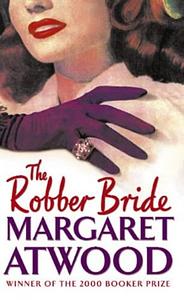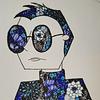Take a photo of a barcode or cover
Jury is still out...really, I'm not too sure about this one....
fiction about a mysterious woman who has impacted three friends’ lives. i went into this knowing nothing and loved its premise as it developed. it was very different from the previous atwood book i read, oryx and crake, but equally enjoyed it for its realistic nature and mystery. the characters all felt realistic and life-like - it was easy to envision them and root for them. i think this is a book that many people will enjoy, from fans of atwood and her work to fans of books about gossip, deception and female villians.
The Real Housewives of Toronto:
Atwood dedicates a lot of space to character description, resulting in excruciatingly slow plot development. And the characters are unlikable, so it's no fun to read about them. They're just annoying and frustrating. Which makes them quite believable, I suppose.
Surely, given Atwood's genius and intentionality, there is some message I'm missing, but it was not a gripping or fun read.
Atwood dedicates a lot of space to character description, resulting in excruciatingly slow plot development. And the characters are unlikable, so it's no fun to read about them. They're just annoying and frustrating. Which makes them quite believable, I suppose.
Surely, given Atwood's genius and intentionality, there is some message I'm missing, but it was not a gripping or fun read.
The story took a long time to get going, and I never really understood the point of why Zenia was so awful. But Atwood's writing is spectacular, as always, and she creates such rich characters that it wasn't painful to read. I enjoyed it, but it's not her best work.
dark
mysterious
reflective
slow-paced
Plot or Character Driven:
Character
Strong character development:
Yes
Loveable characters:
Complicated
Diverse cast of characters:
No
Flaws of characters a main focus:
Yes
Although this story of women's relationships in late 20th century Toronto has been around for some time, it is a wonderful read. True Atwood, the language makes you think in new ways, employs fresh images, and so many lines merit re-reading. You will find the relationships displayed here compelling because of their truthful rendering, then with next page, characters are comical and extreme, as true life can indeed be. One of my all time favorites.
Amazing ride, brutal and tender full of emotional ups and downs. Excellent writing, great characters well fleshed out and believable.
The Robber Bride tells the story of one woman through the eyes of three others; the result is a story about how women see each other, how we project our own hopes, fears and desires onto other figures, thus creating fantasy projections that we ourselves might wish to wear. Really, the story of Zenia is the story of six women - the three protagonists - Tony, Charis and Roz - and the three versions of Zenia, their mutual antagonist.
"How long has she been down here whimpering in the dark? She must go upstairs and face reality, whatever it may be." (Atwood, 429). This line from one of the novel's final chapters captures a truth we all must come to at some point; the realization that the wanderings of the mind into realms of pain and dark imagination at some point becomes self-harm spiral. In order to move on we must turn towards the daylight of what actually is. Even the most destructive figures in one's life can be an opportunity to learn.
The story triangulates around a central figure, Zenia, who returns from the dead. In methodical beauty Atwood shows, turn by turn, how Tony, Charis and Roz each thinks Zenia has come to torment her personally, like a vengeful ghost. From this central point the story spins out to present, past and recent past, introducing the field of each woman's memory as the playing field of the story. Delving further into realms of trauma and imagination, each character's early life is explored, unfolding their personal arcs in a harmonious whole, masterfully woven by Atwood.
Reading "The Robber Bride", published in 1993, I continually recall two other books whose authors must have been influenced by this work: "The Poisonwood Bible" by Barbara Kingsolver, and "Kink" by Kathe Koja. In Poisonwood Bible's Ada must have been partly inspired by Atwood's Tony, who identifies strongly with her left-handedness, using this sense of being an outsider and her ability to read and think backwards as a kind of armor or alternate personality. Tony plays incessantly with language, words and palindromes, finding strength in thinking differently. The dynamic of Zenia entering into three different couples as a disruptive force strongly reminded me of the disruptive character in Koja's "Kink", a woman with a proclivity for dividing and conquering healthy relationships.
Margaret Atwood is undoubtedly one of the strongest writers of the moment. Her mark on modern fiction cannot be ignored. I highly recommend this book as a piece of influential writing that still has the ability to shed new light on friendship and love.
"How long has she been down here whimpering in the dark? She must go upstairs and face reality, whatever it may be." (Atwood, 429). This line from one of the novel's final chapters captures a truth we all must come to at some point; the realization that the wanderings of the mind into realms of pain and dark imagination at some point becomes self-harm spiral. In order to move on we must turn towards the daylight of what actually is. Even the most destructive figures in one's life can be an opportunity to learn.
The story triangulates around a central figure, Zenia, who returns from the dead. In methodical beauty Atwood shows, turn by turn, how Tony, Charis and Roz each thinks Zenia has come to torment her personally, like a vengeful ghost. From this central point the story spins out to present, past and recent past, introducing the field of each woman's memory as the playing field of the story. Delving further into realms of trauma and imagination, each character's early life is explored, unfolding their personal arcs in a harmonious whole, masterfully woven by Atwood.
Reading "The Robber Bride", published in 1993, I continually recall two other books whose authors must have been influenced by this work: "The Poisonwood Bible" by Barbara Kingsolver, and "Kink" by Kathe Koja. In Poisonwood Bible's Ada must have been partly inspired by Atwood's Tony, who identifies strongly with her left-handedness, using this sense of being an outsider and her ability to read and think backwards as a kind of armor or alternate personality. Tony plays incessantly with language, words and palindromes, finding strength in thinking differently. The dynamic of Zenia entering into three different couples as a disruptive force strongly reminded me of the disruptive character in Koja's "Kink", a woman with a proclivity for dividing and conquering healthy relationships.
Margaret Atwood is undoubtedly one of the strongest writers of the moment. Her mark on modern fiction cannot be ignored. I highly recommend this book as a piece of influential writing that still has the ability to shed new light on friendship and love.
Margaret Atwood is one of those writers that really knows how to cut to the core of human nature and display its weaknesses and strengths in powerful characters. That said, I found "The Robber Bride," which tells the story of three women who are manipulated by Xenia, a beautiful pathological liar, to be one of her weaker novels. The characters, while well-drawn and filled with backstory but are also patently unlikeable and annoying. It made it hard for me to be particularly enthusiastic about picking up the book to read on. I also found the ending to be sort of abrupt and tacked on as well. I've loved her other novels (Cat's Eye and of course The Handmaid's Tale in particular) but this one just fell sort of flat for me.
This book is not my favorite Atwood novel, but it still is an interesting look at female relationships.



